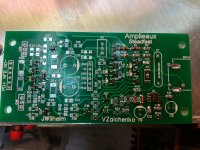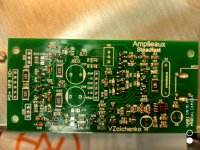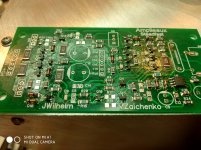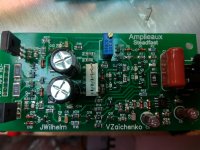It's running nicely now. I did some quick scope tests with +/- 56V rails with teh X4-JFET input and an 8 ohm dummy load. I gave it a short audition too, sounds great, very punchy bass! Dead silent with no signal as always.
Pictures are 1k sine at clipping, 1k square waves, 50k square waves at 100k sine.
Next I need to put together a chassis with proper cooling so I can done some proper high power testing and stereo audition.
Jeff, these are very good ones. Clean clipping, precise 1KHz square, nicely rounded corners at 50KHz. Exactly as expected. X4-jfet does a great job driving the monster. X4 are the great front-ends, somewhat underappreciated by the community, I think 😀
Very very interesting output results!
Mono blocks is the way to go for sure and it also looks really nice this way, beside each speakers...! 🙂
Do
Mono blocks is the way to go for sure and it also looks really nice this way, beside each speakers...! 🙂
Do
Jeff, these are very good ones. Clean clipping, precise 1KHz square, nicely rounded corners at 50KHz. Exactly as expected. X4-jfet does a great job driving the monster. X4 are the great front-ends, somewhat underappreciated by the community, I think 😀
Which jfet is that?
This is not a criticism but a question? Why stick with BJT on the output as opposed to Jfet or Mosfet? Still learning... Cheers
Which jfet is that?
X4-jfet front-end uses 2 pairs of complementary jfets 2sk246/j103 at the input.
Those are still available in some locations. We also have some stock for the kits.
This is not a criticism but a question? Why stick with BJT on the output as opposed to Jfet or Mosfet? Still learning... Cheers
Power jfets are not available these days. MOSFETs - ok, a separate story, we have some good OPS configurations, using them.
However, NS OPS's non-switching mechanism requires a rather precise tuning, based on Vbe (p-n junction voltage drop), inherent in bjt output devices. The non-switching mechanism also requires a rather accurate temperature compensation, designed and fine-tuned for bjt outputs in our case.
So - why not? 🙂 RET-technology bjts are very good output devices.
So far I understand, the NS-circuit is used to reduce crossover distortion. Did you make measurements to compare behavior with NS and without NS in the same circuit?Power jfets are not available these days. MOSFETs - ok, a separate story, we have some good OPS configurations, using them.
However, NS OPS's non-switching mechanism requires a rather precise tuning, based on Vbe (p-n junction voltage drop), inherent in bjt output devices. The non-switching mechanism also requires a rather accurate temperature compensation, designed and fine-tuned for bjt outputs in our case.
So - why not? 🙂 RET-technology bjts are very good output devices.
Is there any benefit for THD mesurement if NS is used?
Another boy in the family!
Steadfast on the road.
Nice work on reflow station .
😛
Nice work on reflow station .
😛
No reflow station used, just hand soldering using 0.5mm solder wire.😉
Cheap solutions here... only. 🙂
Last edited:
Steadfast
Some progress.
Some progress.
Attachments
Last edited:
Please Jeff can you confirm value for R17, R19?
Are these 100R?
I see 100 on schematic when other marked as 100R. 😕
Are these 100R?
I see 100 on schematic when other marked as 100R. 😕
Yes those are both 100R. Lots of parts to this one!
Thanks Jeff.
Yes lot of parts and an empty box of smd transistors. 😎
Thanks Valery, i hope that i will test this tomorrow.🙂Great work Thimios! This is an interesting one. Let's see 😉
- Home
- Amplifiers
- Solid State
- Revisiting some "old" ideas from 1970's - IPS, OPS



